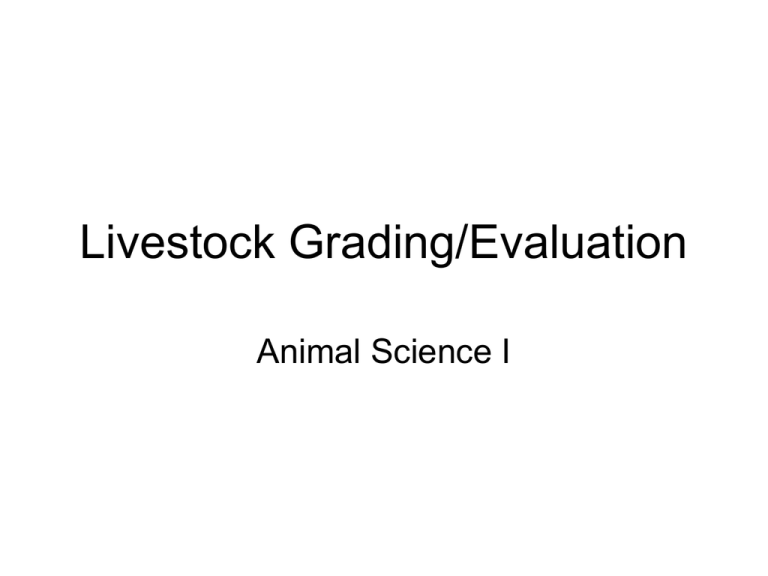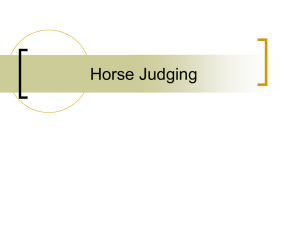
Livestock Grading/Evaluation
Animal Science I
Animal Classes
• Beef
– Age
•
•
•
•
•
Calf – less than one year
Cattle – more than one year
Veal calf – less than 3 months
Slaughter calf – 3 months to 1 year
Feeder calf – 6 months to 1 year
Animal Classes
• Beef
– Sex
•
•
•
•
•
Steer
Heifer
Cow
Bull
Stag
Slaughter Beef Grades
• Slaughter (ready to be killed)
– have 2 grades: quality and yield
• Quality Grade
–
–
–
–
–
–
–
–
Prime
Choice
Select
Standard
Commercial
Utility
Cutter
Canner
Slaughter Cattle Quality Grades
• Determined by age, muscling, and
marbling
Facts You Need To Know
– Standard, Select, Choice, and Prime can not
be older than 42 mths.
• Anything higher is commercial grades
– Utility, Cutter, and Canner have no age limit
– No Prime for cows
– Marbling affects tenderness
– Prime must have maximum marbling
– 80% of all cattle are “choice” grade
Slaughter Beef Grades
• Slaughter (ready to be killed)
– have 2 grades: quality and yield
• Yield Grade
–
–
–
–
–
Yield Grade #1
Yield Grade #2
Yield Grade #3
Yield Grade #4
Yield Grade #5
Slaughter Cattle Yield Grades
• Affected by muscling and amount of fat
– Yield 1 – best muscle with least fat waste
– Yield 2,3,4
– Yield 5 – worst grade, less muscle and more
fat.
Feeder Beef Grades
• Feeder Cattle (still need to be fed) are
graded on:
– Frame size
– Muscle thickness
– Thriftiness
Determining Feeder Cattle Grades
• Will have 2 grades
– Frame Size
• Large
• Medium
• Small
– Thickness
• No. 1
• No. 2
• No. 3
Determining Feeder Cattle Grades
• Frame Size
– Large
• Tall and Long
• Little Fat
– Medium
• Slightly Tall and Long for age
• Some fat
– Small
• Small frame and short
• Fat
Determining Feeder Cattle Grades
• Thickness
– No. 1
• Thick muscling
• Wide
– No. 2
• Moderate muscling
• Somewhat narrow
– No. 3
• Thin muscling
• Very narrow
Review Livestock Grades
• Slaughter Steer/Heifer
– Quality
– Yield
• Feeder Steer/Heifer
– USDA No. 1, No. 2, No. 3
– Large, Medium, Small frames
Animal Classes
• Swine
– Sex
•
•
•
•
•
Barrow
Gilt
Sow
Boar
stag
Swine Classes
• Swine
– Uses
• Slaughter – to be killed and meat sold
• Feeder – to be fed more
Animal Grades
• Swine Grades
– Quality and Yield determine USDA grade
•
•
•
•
•
US No. 1
US No. 2
US No. 3
US No. 4
US Utility
– We use logical slaughter potential and
thriftiness to get grade
Swine Grades
• Grades are determined by:
– Percent of weight made up of:
•
•
•
•
Loin
Ham
Boston shoulder
Picnic shoulder
• Can evaluate live hogs with:
– Backfat
– Degree of muscling
Grading Livestock
• Feeder Swine
– US No. 1 – US Utility
• Utility is diseased, unthrifty, head appears to big for
body and has wrinkled skin.
• US No. 1 has thick muscle, large frame, and is trim
• A US No. 1 must be no less than average muscled
Determining Swine Grades
• Grade =
– (4 x backfat thickness in inches) – (muscling
score)
– Muscling scores are:
» Thin = 1
» Average = 2
» Thick = 3
– Example – 240 lb. gilt has 1.05 inches of
backfat and is thick muscled.
• =1.2 so grade is US No. 1
Determining Swine Grades
• Or you can do this:
– Backfat Thickness
•
•
•
•
Less than 1 inch is No. 1
1.00 – 1.24 inches is No. 2
1.25 – 1.49 inches is No. 3
1.50 or over is No. 4
• Add one grade for Thick muscled
• Subtract one grade for Thin muscled
• Stay the same for Average muscled
– Remember a thin muscled pig can never be a No. 1







